
- Current
- Browse
- Collections
-
For contributors
- For Authors
- Instructions to authors
- Article processing charge
- e-submission
- For Reviewers
- Instructions for reviewers
- How to become a reviewer
- Best reviewers
- For Readers
- Readership
- Subscription
- Permission guidelines
- About
- Editorial policy
Articles
- Page Path
- HOME > Diabetes Metab J > Volume 34(2); 2010 > Article
-
Original ArticleThe Effects of Resistance Training on Muscle and Body Fat Mass and Muscle Strength in Type 2 Diabetic Women
- Hwi Ryun Kwon1, Kyung Ah Han2, Yun Hyi Ku2, Hee Jung Ahn1, Bo-Kyung Koo3, Ho Chul Kim4, Kyung Wan Min2
-
Korean Diabetes Journal 2010;34(2):101-110.
DOI: https://doi.org/10.4093/kdj.2010.34.2.101
Published online: April 30, 2010
- 4,994 Views
- 73 Download
- 55 Crossref
1Diabetes Center, Eulji Hospital, Seoul, Korea.
2Department of Internal Medicine, Eulji University School of Medicine, Daejeon, Korea.
3Department of Internal Medicine, Seoul National University College of Medicine, Seoul, Korea.
4Kim Ho Chul Radiology Clinic, Seoul, Korea.
- Corresponding author: Kyung-Wan Min. Diabetes Center, Eulji Hospital, 280-1 Hagye 1-dong, Nowon-gu, Seoul 139-872, Korea. minyungwa@yahoo.co.kr
- *Hwi Ryun Kwon and Kyung-Ah Han jointly contribute to this paper as first authors.
• Received: January 6, 2010 • Accepted: March 4, 2010
Copyright © 2010 Korean Diabetes Association
This is an Open Access article distributed under the terms of the Creative Commons Attribution Non-Commercial License (http://creativecommons.org/licenses/by-nc/3.0/) which permits unrestricted non-commercial use, distribution, and reproduction in any medium, provided the original work is properly cited.
Figure & Data
References
Citations
Citations to this article as recorded by 

- The Impact of Resistance Exercise Training on Glycemic Control Among Adults with Type 2 Diabetes: A Systematic Review and Meta-Analysis of Randomized Controlled Trials
Yuwen Wan, Zhanguo Su
Biological Research For Nursing.2024;[Epub] CrossRef - Current trends in the development of soy-based foods containing probiotics and paving the path for soy-synbiotics
Minnu Sasi, Sandeep Kumar, Muzaffar Hasan, Arpitha S. R., Enriqueta Garcia-Gutierrez, Sweta Kumari, Om Prakash, Lata Nain, Archana Sachdev, Anil Dahuja
Critical Reviews in Food Science and Nutrition.2023; 63(29): 9995. CrossRef - Communication Strategies and Resources for Health and Fitness Professionals to Minimize Diabetes-Related Social Stigma
Lindsay J. Della, Annika Reitenga, Kristi M. King
ACSM'S Health & Fitness Journal.2023; 27(2): 54. CrossRef - IMPACTS OF MUSCLE TRAINING LOADS ON COLLEGE STUDENTS' PHYSICAL FITNESS
Wang Lu, Zheng Hua, Wang Tailin, Wei Xuanxi
Revista Brasileira de Medicina do Esporte.2023;[Epub] CrossRef - Effect of resistance training on HbA1c in adults with type 2 diabetes mellitus and the moderating effect of changes in muscular strength: a systematic review and meta-analysis
Anna K Jansson, Li X Chan, David R Lubans, Mitch J Duncan, Ronald C Plotnikoff
BMJ Open Diabetes Research & Care.2022; 10(2): e002595. CrossRef - Role of genetic factors (biology of telomeres) in cardiac rehabilitation
D. M. Aronov, O. M. Drapkina, M. G. Bubnova
Cardiovascular Therapy and Prevention.2022; 21(6): 3272. CrossRef - Effects of 12-Week Progressive Sandbag Exercise Training on Glycemic Control and Muscle Strength in Patients with Type 2 Diabetes Mellitus Combined with Possible Sarcopenia
Yu-Hsuan Chien, Chia-Jen Tsai, Dean-Chuan Wang, Pin-Hung Chuang, Hwai-Ting Lin
International Journal of Environmental Research and Public Health.2022; 19(22): 15009. CrossRef - Effects of Online Live Pilates Training during the COVID-19 Pandemic on Body Composition, Cardiovascular Function, and Physical Fitness in Sedentary Middle-aged Obese Women
Jung-Heon Choi, Ko-Eun Choi, Man-Gyoon Lee
Korean Journal of Sport Science.2022; 33(4): 521. CrossRef - Muscular Strength, Functional Fitness, Body Composition, and Quality of Life after 12 Weeks of Detraining in Older Females
Matúš Krčmár, Nora Halmová, Jaroslav Krajčovič, Bohumila Krčmárová
Physical & Occupational Therapy In Geriatrics.2021; 39(2): 129. CrossRef - Comparison between different types of exercise training in patients with type 2 diabetes mellitus: A systematic review and network metanalysis of randomized controlled trials
Edoardo Mannucci, Allegra Bonifazi, Matteo Monami
Nutrition, Metabolism and Cardiovascular Diseases.2021; 31(7): 1985. CrossRef - DETERMINING NEW ANTHROPOMETRIC MARKERS FOR SCREENING TYPE 2 DM IN A CARIBBEAN REGION.
Amruta Rajput, Upendra K Gupta, Guri Tzivion, Ravindrasingh Rajput
INTERNATIONAL JOURNAL OF SCIENTIFIC RESEARCH.2021; : 58. CrossRef - Effect of elastic band resistance training with green coffee extract supplementation on adiposity indices and TyG-related Indicators in Obese Women
Zahra Rashidi, Rezvan Beigi, Majid Mardaniyan Ghahfarrokhi, Mohammad Faramarzi, Ebrahim Banitalebi, Tina Jafari, Conrad P. Earnest, Julien S. Baker
Obesity Medicine.2021; 24: 100351. CrossRef - Effect of resistance training with and without caloric restriction on visceral fat: A systemic review and meta‐analysis
Mousa Khalafi, Abbas Malandish, Sara K. Rosenkranz, Ali A. Ravasi
Obesity Reviews.2021;[Epub] CrossRef - The Effect of Elastic Resistance Band Training on Postural Control and Body Composition in Sedentary Women
Yağmur KOCAOĞLU, Nurtekin ERKMEN
Spor Bilimleri Araştırmaları Dergisi.2021; 6(1): 233. CrossRef - Strength Training and Insulin Resistance: The Mediating Role of Body Composition
McKayla J. Niemann, Larry A. Tucker, Bruce W. Bailey, Lance E. Davidson
Journal of Diabetes Research.2020; 2020: 1. CrossRef - Beyond general resistance training. Hypertrophy versus muscular endurance training as therapeutic interventions in adults with type 2 diabetes mellitus: A systematic review and meta‐analysis
Pedro Acosta‐Manzano, María Rodriguez‐Ayllon, Francisco M. Acosta, David Niederseer, Josef Niebauer
Obesity Reviews.2020;[Epub] CrossRef - Resistance Exercise Intensity is Correlated with Attenuation of HbA1c and Insulin in Patients with Type 2 Diabetes: A Systematic Review and Meta-Analysis
Yubo Liu, Weibing Ye, Qian Chen, Yong Zhang, Chia-Hua Kuo, Mallikarjuna Korivi
International Journal of Environmental Research and Public Health.2019; 16(1): 140. CrossRef - Effectiveness of Exercise Intervention in Reducing Body Weight and Glycosylated Hemoglobin Levels in Patients with Type 2 Diabetes Mellitus in Korea: A Systematic Review and Meta-Analysis
Ji-Eun Jang, Yongin Cho, Byung Wan Lee, Ein-Soon Shin, Sun Hee Lee
Diabetes & Metabolism Journal.2019; 43(3): 302. CrossRef - Effects of a moderate-to-high intensity resistance circuit training on fat mass, functional capacity, muscular strength, and quality of life in elderly: A randomized controlled trial
Pablo Jorge Marcos-Pardo, Francisco Javier Orquin-Castrillón, Gemma María Gea-García, Ruperto Menayo-Antúnez, Noelia González-Gálvez, Rodrigo Gomes de Souza Vale, Alejandro Martínez-Rodríguez
Scientific Reports.2019;[Epub] CrossRef - Effects of Resistance Exercise on Glycated Hemoglobin and Functional Performance in Older Patients with Comorbid Diabetes Mellitus and Knee Osteoarthritis: A Randomized Trial
Shu-Mei Chen, Feng-Chih Shen, Jung-Fu Chen, Wen-Dien Chang, Nai-Jen Chang
International Journal of Environmental Research and Public Health.2019; 17(1): 224. CrossRef - Effects of low‐intensity resistance training on muscular function and glycemic control in older adults with type 2 diabetes
Eri Takenami, ShinMin Iwamoto, Noriko Shiraishi, Akiko Kato, Yuichi Watanabe, Yoshifumi Yamada, Satoru Yamada, Naokata Ishii
Journal of Diabetes Investigation.2019; 10(2): 331. CrossRef - Effect of 12-Month Resistance Training on Changes in Abdominal Adipose Tissue and Metabolic Variables in Patients with Prediabetes: A Randomized Controlled Trial
Juan Yan, Xia Dai, Jitao Feng, Xiaodan Yuan, Jianing Li, Lihong Yang, Panpan Zuo, Zhaohui Fang, Chao Liu, Cunyi Hsue, Junya Zhu, Joshua D. Miller, Qingqing Lou
Journal of Diabetes Research.2019; 2019: 1. CrossRef - Positive Effects of a Short-Term Intense Elastic Resistance Training Program on Body Composition and Physical Functioning in Overweight Older Women
Nicole B. Fritz, Álvaro Juesas, Pedro Gargallo, Joaquín Calatayud, Julio Fernández-Garrido, Michael E. Rogers, Juan C. Colado
Biological Research For Nursing.2018; 20(3): 321. CrossRef - Protein timing during the day and its relevance for muscle strength and lean mass
Samuel L. Buckner, Jeremy P. Loenneke, Paul D. Loprinzi
Clinical Physiology and Functional Imaging.2018; 38(2): 332. CrossRef - Exercise training modalities in patients with type 2 diabetes mellitus: a systematic review and network meta-analysis
Bei Pan, Long Ge, Yang-qin Xun, Ya-jing Chen, Cai-yun Gao, Xue Han, Li-qian Zuo, Hou-qian Shan, Ke-hu Yang, Guo-wu Ding, Jin-hui Tian
International Journal of Behavioral Nutrition and Physical Activity.2018;[Epub] CrossRef - Resistance training reduces metabolic syndrome and inflammatory markers in older women: A randomized controlled trial
Crisieli M. Tomeleri, Mariana F. Souza, Roberto C. Burini, Cláudia R. Cavaglieri, Alex S. Ribeiro, Melissa Antunes, João P. Nunes, Danielle Venturini, Décio S. Barbosa, Luís B. Sardinha, Edilson S. Cyrino
Journal of Diabetes.2018; 10(4): 328. CrossRef - Effect of Resistance Training with Blood Flow Restriction on Follistatin to Myostatin Ratio, Body Composition and Anaerobic Power of Trained-Volleyball Players
Reza Bagheri, Amir Rashidlamir, Seyyed Reza Attarzadeh Hosseini
Medical Laboratory Journal.2018; 12(6): 28. CrossRef - Effects of 8-week kettlebell training on body composition, muscle strength, pulmonary function, and chronic low-grade inflammation in elderly women with sarcopenia
Hung-Ting Chen, Huey-June Wu, Yu-Jen Chen, Sung-Yen Ho, Yu-Chun Chung
Experimental Gerontology.2018; 112: 112. CrossRef - F inding the O ptimal volume and intensity of R esistance T raining E xercise for Type 2 Diabetes: The FORTE Study, a Randomized Trial
Pearl Yang, Walter Swardfager, Daniel Fernandes, Sheila Laredo, George Tomlinson, Paul I. Oh, Scott Thomas
Diabetes Research and Clinical Practice.2017; 130: 98. CrossRef - Exercise and ectopic fat in type 2 diabetes: A systematic review and meta-analysis
A. Sabag, K.L. Way, S.E. Keating, R.N. Sultana, H.T. O’Connor, M.K. Baker, V.H. Chuter, J. George, N.A. Johnson
Diabetes & Metabolism.2017; 43(3): 195. CrossRef - Resistance training to improve type 2 diabetes: working toward a prescription for the future
Dominik H. Pesta, Renata L. S. Goncalves, Anila K. Madiraju, Barbara Strasser, Lauren M. Sparks
Nutrition & Metabolism.2017;[Epub] CrossRef - Improvement of obesity-linked skeletal muscle insulin resistance by strength and endurance training
Sergio Di Meo, Susanna Iossa, Paola Venditti
Journal of Endocrinology.2017; 234(3): R159. CrossRef - Leisure time sedentary behavior, physical activity and frequency of protein consumption on lower extremity strength and lean mass
P D Loprinzi, J P Loenneke, D L Hamilton
European Journal of Clinical Nutrition.2017; 71(12): 1399. CrossRef - Strength Training Prevents Hyperinsulinemia, Insulin Resistance, and Inflammation Independent of Weight Loss in Fructose-Fed Animals
José D. Botezelli, Andressa Coope, Ana C. Ghezzi, Lucieli T. Cambri, Leandro P. Moura, Pedro P. M. Scariot, Rodrigo Stellzer Gaspar, Rania A. Mekary, Eduardo Rochete Ropelle, José Rodrigo Pauli
Scientific Reports.2016;[Epub] CrossRef - Effects of Elastic Band Resistance Training on Glucose Control, Body Composition, and Physical Function in Women With Short- vs. Long-Duration Type-2 Diabetes
Bong-Sup Park, Andy V. Khamoui, Lee E. Brown, Do-Youn Kim, Kyung-Ah Han, Kyung-Wan Min, Geun-Hee An
Journal of Strength and Conditioning Research.2016; 30(6): 1688. CrossRef - Neuromuscular dysfunction in type 2 diabetes: underlying mechanisms and effect of resistance training
Giorgio Orlando, Stefano Balducci, Ilenia Bazzucchi, Giuseppe Pugliese, Massimo Sacchetti
Diabetes/Metabolism Research and Reviews.2016; 32(1): 40. CrossRef - Physical exercises with free weights and elastic bands can improve body composition parameters in postmenopausal women
Simoni T. Bittar, Sergio S. Maeda, Marília M.S. Marone, Cláudio Santili
Menopause.2016; 23(4): 383. CrossRef - Effects of exercise training using resistance bands on glycaemic control and strength in type 2 diabetes mellitus: a meta-analysis of randomised controlled trials
Samantha K. McGinley, Marni J. Armstrong, Normand G. Boulé, Ronald J. Sigal
Acta Diabetologica.2015; 52(2): 221. CrossRef - Effect of exercise training on neuromuscular function of elbow flexors and knee extensors of type 2 diabetic patients
I. Bazzucchi, G. De Vito, F. Felici, S. Dewhurst, A. Sgadari, M. Sacchetti
Journal of Electromyography and Kinesiology.2015; 25(5): 815. CrossRef - Effects of short term elastic resistance training on muscle mass and strength in untrained older adults: a randomized clinical trial
Wagner Rodrigues Martins, Marisete Peralta Safons, Martim Bottaro, Juscelino Castro Blasczyk, Leonardo Rios Diniz, Romulo Maia Carlos Fonseca, Ana Clara Bonini-Rocha, Ricardo Jacó de Oliveira
BMC Geriatrics.2015;[Epub] CrossRef - Brain-derived neurotrophic factor correlated with muscle strength in subjects undergoing stationary bicycle exercise training
Sen-Wei Tsai, Yin-Ching Chan, Francois Liang, Chiann-Yi Hsu, I-Te Lee
Journal of Diabetes and its Complications.2015; 29(3): 367. CrossRef - Implementation of Resources to Support Patient Physical Activity through Diabetes Centres in Nova Scotia: The Effectiveness of Enhanced Support for Exercise Participation
Jonathon R. Fowles, Chris Shields, Lisette d’Entremont, Stephanie McQuaid, Brittany Barron, Peggy Dunbar
Canadian Journal of Diabetes.2014; 38(6): 423. CrossRef - Changes in insulin sensitivity in response to different modalities of exercise: a review of the evidence
S. Mann, C. Beedie, S. Balducci, S. Zanuso, J. Allgrove, F. Bertiato, A. Jimenez
Diabetes/Metabolism Research and Reviews.2014; 30(4): 257. CrossRef - The surprising influence of family history to type 2 diabetes on anaerobic performance of young male élite athletes
Antonino Bianco, Francesco Pomara, Antonino Patti, Ewan Thomas, Marco Petrucci, Marianna Bellafiore, Giuseppe Battaglia, Antonio Paoli, Antonio Palma
SpringerPlus.2014;[Epub] CrossRef - Skeletal muscle and organ masses differ in overweight adults with type 2 diabetes
Lance E. Davidson, David E. Kelley, Stanley Heshka, John Thornton, F. Xavier Pi-Sunyer, Lawrence Boxt, Ashok Balasubramanyam, Dympna Gallagher
Journal of Applied Physiology.2014; 117(4): 377. CrossRef - The effects of elastic band resistance training combined with blood flow restriction on strength, total bone‐free lean body mass and muscle thickness in postmenopausal women
Robert S. Thiebaud, Jeremy P. Loenneke, Christopher A. Fahs, Lindy M. Rossow, Daeyeol Kim, Takashi Abe, Mark A. Anderson, Kaelin C. Young, Debra A. Bemben, Michael G. Bemben
Clinical Physiology and Functional Imaging.2013; 33(5): 344. CrossRef - Predicting Aerobic Fitness Improvements after Participation in a Hybrid Supervised and Home-Based Exercise Program in People with Type 2 Diabetes
Pearl Yang, Paul Oh
Canadian Journal of Diabetes.2013; 37(6): 388. CrossRef - Impacto do treinamento resistido na força e hipertrofia muscular em HIV-soropositivos
Ciro José Brito, Edmar Lacerda Mendes, Aparecido Pimentel Ferreira, Sérgio Oliveira De Paula, Otávio de Tolêdo Nóbrega, Cláudio Córdova
Motriz: Revista de Educação Física.2013; 19(2): 313. CrossRef - Resistance Training for Diabetes Prevention and Therapy: Experimental Findings and Molecular Mechanisms
Barbara Strasser, Dominik Pesta
BioMed Research International.2013; 2013: 1. CrossRef - Resistance training, visceral obesity and inflammatory response: a review of the evidence
B. Strasser, M. Arvandi, U. Siebert
Obesity Reviews.2012; 13(7): 578. CrossRef - The effects of resistance training on ApoB/ApoA-I ratio, Lp(a) and inflammatory markers in patients with type 2 diabetes
Nikolaos P. E. Kadoglou, Grigorios Fotiadis, Zoi Athanasiadou, Ioulia Vitta, Stylianos Lampropoulos, Ioannis S. Vrabas
Endocrine.2012; 42(3): 561. CrossRef - A systematic review and meta‐analysis of the effect of aerobic vs. resistance exercise training on visceral fat
I. Ismail, S. E. Keating, M. K. Baker, N. A. Johnson
Obesity Reviews.2012; 13(1): 68. CrossRef - Aging, Resistance Training, and Diabetes Prevention
Kyle D. Flack, Kevin P. Davy, Matthew W. Hulver, Richard A. Winett, Madlyn I. Frisard, Brenda M. Davy
Journal of Aging Research.2011; 2011: 1. CrossRef - The Effects of Aerobic/Resistance Exercise on Body Fat Mass, Muscle Strength and Endothelial Function in Korean Type 2 Diabetes mellitus Patients
Kyung Wan Min
Journal of Korean Diabetes.2011; 12(1): 6. CrossRef - Exercise and Type 2 Diabetes
Sheri R. Colberg, Ronald J. Sigal, Bo Fernhall, Judith G. Regensteiner, Bryan J. Blissmer, Richard R. Rubin, Lisa Chasan-Taber, Ann L. Albright, Barry Braun
Diabetes Care.2010; 33(12): e147. CrossRef

 KDA
KDA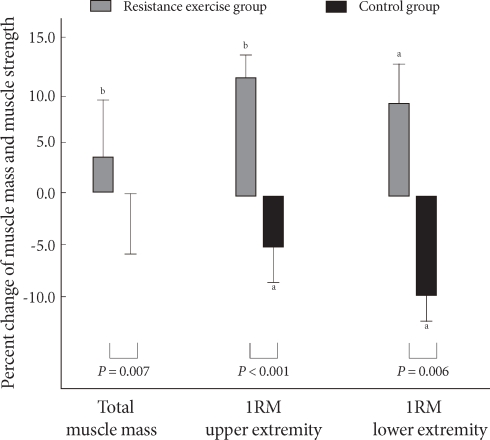
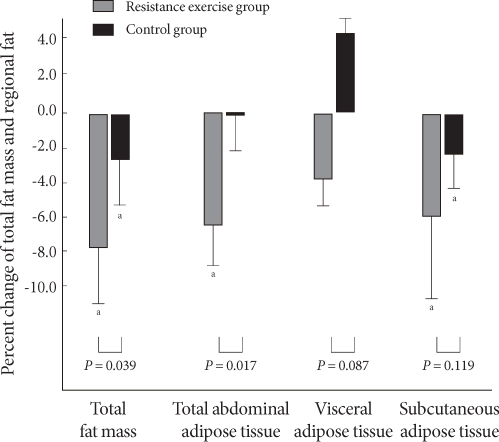
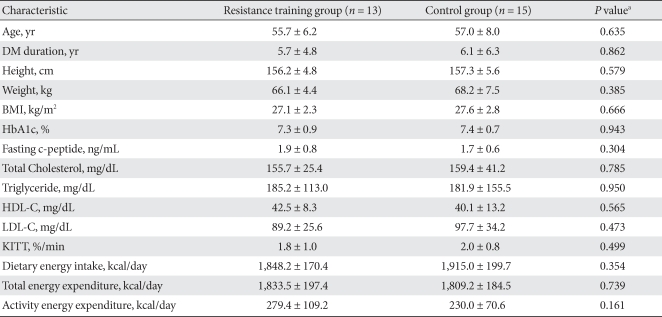
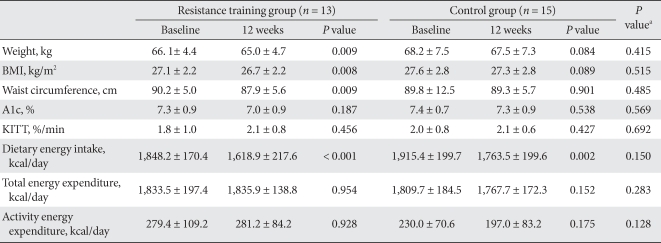
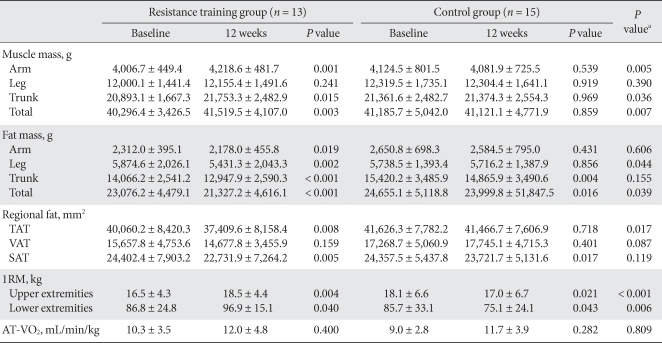
 PubReader
PubReader Cite
Cite





